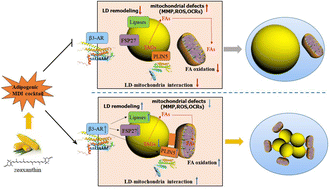Zeaxanthin remodels cytoplasmic lipid droplets via β3-adrenergic receptor signaling and enhances perilipin 5-mediated lipid droplet–mitochondrion interactions in adipocytes†
Abstract
Cytoplasmic lipid droplets (LDs), which are remarkably dynamic, neutral lipid storage organelles, play fundamental roles in lipid metabolism and energy homeostasis. Both the dynamic remodeling of LDs and LD–mitochondrion interactions in adipocytes are effective mechanisms to ameliorate obesity and related comorbidities. Zeaxanthin (ZEA) is a natural carotenoid and has beneficial effects on anti-obesity. However, the underlying mechanisms of ZEA on LD modulation are still unclear. In the present study, ZEA efficiently inhibited LD accumulation and attenuated adipocyte proliferation by arresting the cell cycle. ZEA drove transcriptional alterations to reprogram a lipid oxidative metabolism phenotype in mature 3T3-L1 adipocytes. ZEA significantly decreased the TAG and FA content and modulated the dynamic alterations of LDs by upregulating the expression of lipases and the LD–mitochondrion contact site protein, perilipin 5 (PLIN5), and downregulating the LD fusion protein, fat-specific protein 27 (FSP27). Mechanistically, ZEA stimulated LD remodeling and ameliorated mitochondrial defects caused by large and unilocular LD accumulation by activating β3-adrenergic receptor (β3-AR) signaling. Furthermore, the knockdown of PLIN5 impaired the LD–mitochondrion interactions, thereby disrupting the role of ZEA in promoting mitochondrial fatty acid oxidation and respiratory chain operation. Collectively, the present study demonstrates that ZEA induces LD structural and metabolic remodeling by activating β3-AR signaling and enhances PLIN5-mediated LD–mitochondrion interactions in hypertrophic white adipocytes, thereby enhancing oxidative capacity, and has the potential as a nutritional intervention for the prevention and treatment of obesity and associated metabolic syndrome.



 Please wait while we load your content...
Please wait while we load your content...